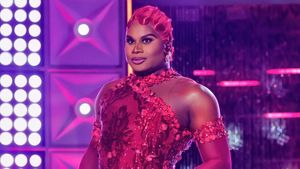This interview was conducted as part of the interview series, LGBTQ&A, a weekly podcast that documents modern queer and trans history.
Vida shows how complicated the sex lives of queer people -- of all people, really -- can be. Tanya Saracho, the TV show's creator, wants audiences to feel like they're there in person, watching along as the intimate moments most TV shows cut away from.
"Those sex scenes are shot very specifically," she says. "The uncomfortable parts, we want to stay and linger in them."
Tanya Saracho talks about workshopping these scenes, showing a different side of nonbinary people onscreen, and what to expect in the upcoming second season of Vida on this week's episode of The Advocate's podcast, LGBTQ&A.
[Read highlights below & click here for the full interview with Tanya Saracho.]
Jeffrey Masters: Sometimes I watch Vida and I can't believe a lot of the things you're able to do on the show.
Tanya Saracho: It's funny, because I walk in my surprise, but also my gratitude. It's just the fact that it resonated with so many people and not just Latinx queers. It has so many concentric circles: immigrant, children of immigrants, or if you have loss.
Also, the way we're shooting it resonates with people. Those sex scenes are shot very specifically: the uncomfortable parts, we want to stay and linger in them. It's a little bit more voyeuristic, where you see a little too much that in another show, you wouldn't see. I want you to feel like you're there.
JM: In the pilot, we see a guy eating out a girl.
TS: Yeah, he's eating her out while people are upstairs mourning the mom.
JM: On a different show, those roles would have been reversed. She'd be going down on him.
TS: Oh yeah. And actually, both those girls are tops. They are alphas. Emma is a femme top and you can tell. She's got her nails. If you look at the signs, you see them, but we're never going to be overt about them or explain.
There's one scene in the whole season where she gets to close to explaining it, and all she explains is, "I don't want to explain." That's basically what she says, and I think it's real, you know?
JM: I don't think I've ever heard "femme top" used to describe a female character on TV before.
TS: Right. The way we curated the scene with a nonbinary person... there's a perception that maybe nonbinary people are more masc and they're a top, but Emma's topping the non-binary person, and that, we workshopped.
Most of my room that first season was brown, queer women. My whole room is Latinx, but there's one cis male. We workshopped that scene because we wanted to get it right: not surprising, but real.
Vida never wants to be surprising for the sake of being surprising. It's just like, "What's true to life? What's my experience?" We share our experiences in the writer's room, and then what you saw was the most workshopped, curated, right version of that."
JM: We see this female character being sexually ruthless.
TS: She just face-sits. We have face-sitting. I love that.
We also otherize whiteness a little bit, because it's a brown, female gaze. It's not just a female, it's a brown female gaze.
JM: You also complicate this Latinx narrative by having brown people otherize brown.
TS: Yeah, because that's the theme of the show: gentefication, not gentrification.
Gentefication is the gentrification of a Latinx space by an upwardly mobile Latinx.
It's like we are gentrifying our own and that's what the show is. It's complicated because these girls are from the neighborhood, but now they're coming back and making changes.
You will that in the second season. The small changes in the bar will attract a different kind of patron and so it will gentrify.
[Click here to listen to the full LGBTQ&A podcast, only on Luminary.]
The second season of Vida debuts on May 23 on Starz.
RELATED | Vida Boldly Tackles Identity Policing Among Queer People


















































































